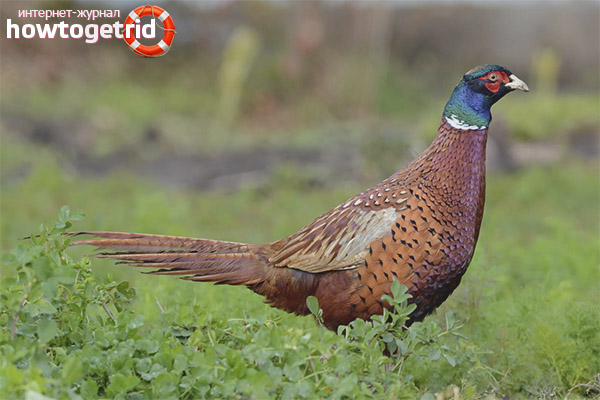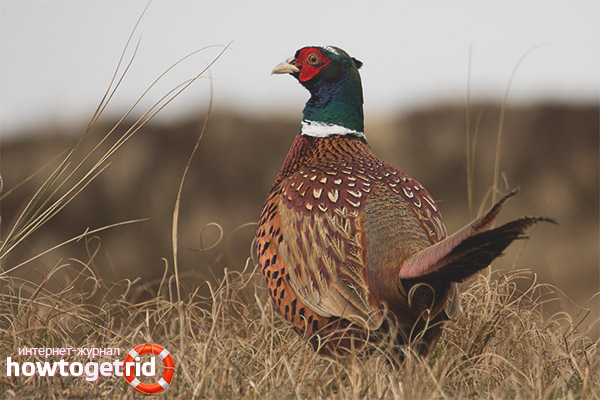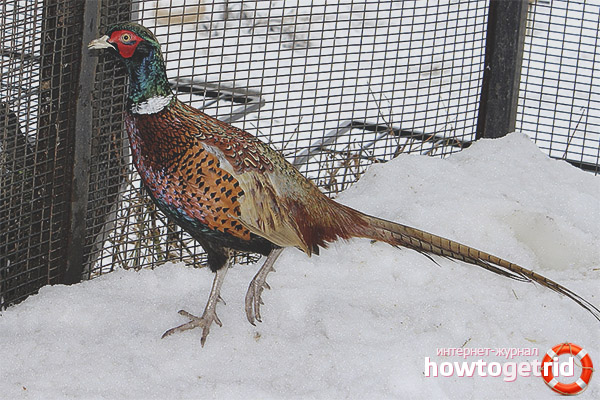The content of the article
Pheasant is a fairly popular bird belonging to the pheasant family. A species of common pheasant for a long period was considered the best game. They were caught for rich European estates and served only on special occasions. Pheasant dishes have always been considered a special treat. Today, pheasants can be bred even at home.
Domestication process
The second name of the common pheasant is the Caucasian pheasant. This species of bird is classified as a chickens order. It is surprising that this representative, in fact, is a relative of ordinary domestic chicken, but at the same time also becomes the desired object for the extraction of all hunters.
If you believe the ancient myth from Greece, the pheasant in Europe appeared thanks to the sailors who brought this bird from Colchis when they went on a journey for the golden fleece. I must say that this is partly true. It was the Greeks, back in the days of Aristotle, who brought the common pheasant to Europe. After that, this variety appeared in the Roman Empire, and then spread to Austria, Germany, the Czech Republic and Hungary. In the 19th century, pheasants began to be found in North America as well as in Australia.
It is worth noting that pheasants were often bred at home, however, this did not make the species a completely domestic breed, since there was no particular economic benefit. Most often, pheasants were bred by the owners of rich estates, which later used birds to organize hunting. Only in the 20th century did pheasants become considered semi-domestic or poultry.
Appearance
The main distinguishing feature of pheasants is a rather long tail, which has the shape of a wedge. The tail consists of 18 feathers, which gradually taper towards the end. Representatives of the male half of pheasants have a brown tail, sometimes even copper in color with a red tint, a purple strip can be distinguished along the edges of the tail. In females, the tail is less bright, usually dull brown. Common carp from the north are distinguished by their color. In the area of the head and neck, one can note feathers of green and golden color, orange feathers on the back, the border of which turns into black.
Common Features with Guinea Fowl
Many say that pheasant meat is similar to guinea fowl meat. This is not surprising, because guinea fowl or "royal" birds also belong to the order of chicken. Guinea fowl differ in that they are smaller in size than pheasants. The maximum mass of the latter is 1600 grams.
You can also distinguish a guinea fowl from a pheasant by the color of its plumage. The "royal birds" feathers are gray-white, and spotted color is also present. Pheasants are brighter birds, the color of which is very diverse.
Natural distribution of pheasants
Under natural conditions, pheasants can be found in almost all parts of Eurasia, birds are distributed from the Black Sea to Japan. It is worth noting that these individuals perfectly live both in the mountains and in the lowlands. In connection with such a wide distribution, one might even think that any conditions for life are suitable for these representatives.However, in reality, pheasants select strictly those areas in which there is dense vegetation, it is better if it is prickly and interwoven. Another important factor for these birds is the location of the nearby water source. Even in the mountains or in the steppe, pheasants are traditionally located on the banks of rivers and streams, where there are also thickets of reeds and various shrubs.
In addition, pheasants can often be found near agricultural land. In these areas, birds feed mainly, but nests are never satisfied, because here they can be destroyed by dogs, cats and rats. Pheasants nests are arranged just in the thickets of reeds or thorny bushes, where it will be quite difficult to get to them.
In vivo, almost everyone eats. They can feed on insects, small lizards and worms. The process of finding food and feeding pheasants is the main activity, as the birds devote all their time to this, except for the period that they spend on sleeping or cleaning feathers.
Adult pheasants also enjoy eating young plant leaves, berries, seeds and fruits. It is important to note that these birds peck only what is located either on the ground or on fairly tall plants. Pheasants do not know how to eat directly on trees, but if birds are in danger, they can hide on high branches.
How to care for pheasants at home?
In general, pheasants are traditionally considered wild birds, however, today they are very common as pets. These birds look very aesthetically pleasing due to their beautiful and bright plumage. However, the main value in this case is, of course, pheasant meat. Many gourmets have recognized this meat as a valuable product. In addition, eggs are also used for food, and these birds give the same number of eggs as ordinary domestic hens.
In general, keeping pheasants at home is not difficult, this process resembles keeping chickens. Of course, there are some features in the maintenance and breeding of these birds, however, they are completely not burdensome. In addition, keeping pheasants is not only beneficial, but also interesting, and therefore even some features of bird breeding become uncomplicated.
Today, many restaurant complexes are willing to buy pheasant meat, as this product is a delicacy. Moreover, additional money can be obtained from the sale of eggs and even feathers. The development of decorative birds, which are acquired mainly for house maintenance, is another area of this business.
Birds of this species are also very valuable for hunting farms. Similar organizations buy live pheasants for hunting.
The organization of cells or any premises is not required for the maintenance of pheasants. The fact is that pheasants live quietly all year round in the open air in the middle climate. Pheasants are not at all afraid of frost and, thanks to their beautiful and warm plumage, can safely winter on the street.
In order to start breeding pheasants, you need to buy their eggs, or to get adults of different sexes, but of one species. After this, the breeder should carefully study the variety and characteristics of the breeding.
How to feed the birds at home?
Before buying birds and organizing space for them, it is very important to study the characteristics of pheasants, and also to understand how they can be fed.
These representatives differ in that they live quite a long time. Under natural conditions, the average lifespan of these birds is approximately 5-7 years. In the case when circumstances are more favorable, these individuals can live up to 15 years.At home, pheasants are able to live up to 18 years, but only on condition that they are provided with comfortable living conditions.
In farm conditions or just at home breeding pheasants, from birth they first begin to feed them boiled eggs, which are previously finely chopped. You can add greens to the eggs, which are also required to be finely cut, as well as mealy worms. Feed pheasants the first time you need every two hours. If after feeding some food remains, it must immediately be thrown out. At night, pheasants are also fed, it will be enough twice for the whole night. Feeding should be carried out in the presence of lighting, for about half an hour. Combined feed can also be added to food during this period.
Once the chicks are one week old, you can enrich their diet with boiled millet, to which you should also add finely chopped greens. In the future, feed, millet, and crushed corn should also be added to the menu. From greens should choose clover and dandelion.
Adult pheasants are perfect as feed for chicken feed, millet, sunflower seeds, and corn. It is recommended that adults also give snails. It is worth noting that birds of this breed will gladly eat even Colorado beetles. It is necessary to give them an additional cake. In winter, the diet of birds should be supplemented with sugar, fish oil, and ascorbic acid. These products are necessary for pheasants to enhance the body's immune defenses.
Behavior and breeding of pheasants
An interesting feature of pheasants is that they can move very quickly on the ground on their paws, but flying, even for a short time, is too difficult a task for them that they are not ready to perform, so it is extremely rare to see flying pheasants. Male pheasants always carefully guard their territory and nests. Sometimes birds are even able to sacrifice their lives, but not to allow the enemy to the nest. The settlements of these birds can most often be found near water bodies in thickets of various plants.
In the heat of the day, pheasants hide under the plants, in the same thicket where they build nests. For hunting and feeding birds leave evening time, as well as morning. Pheasants also sleep next to nests in the shade of plants.
Before spring, pheasants live in packs that consist of individuals of the same sex. In males, flocks, as a rule, are more numerous than in females. As soon as the first signs of spring appear, the male is separated from the pack and selects a female. After that, he begins to sing songs in a hoarse voice in order to attract the attention of the opposite side, as well as inform other males that the female is already busy so that no one else claims to be.
Next, the process of organizing the nest. It is traditionally located in the grass in the thickets of plants so that the nesting site is not visible from the side. The female of pheasants independently incubates eggs, and in general takes care of herself all the time that incubation takes. The male does not take any part in this process at all. From the time of laying the eggs to the appearance of the first chicks, traditionally takes about a month. For one clutch, a couple can have from one to twenty chicks. Under natural conditions, pheasants lead a monogamous life.
Video: breeding pheasants and their breeds













Submit